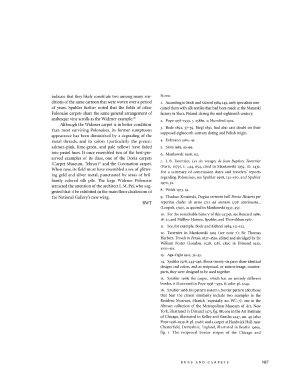Page 313 - Decorative Arts, Part II: Far Eastern Ceramics and Paintings, Persian and Indian Rugs and Carpets
P. 313
indicate that they likely constitute two among many ren- NOTES
ditions of the same cartoon that were woven over a period 1. According to Bode and Kiihnel 1984,149, early specialists asso-
of years. Spuhler further noted that the fields of other ciated them with silk textiles that had been made at the Mazarski
Polonaise carpets share the same general arrangement of factory in Slucz, Poland, during the mid-eighteenth century.
arabesque vine scrolls as the Widener example. 16 2. Pope 1938-1939, 3, 2388n. 2; Mumford 1902.
Although the Widener carpet is in better condition
doubt
than most surviving Polonaises, its former sumptuous 3. Bode 1892, 37-39. Riegl 1891, had also cast origin. on their
supposed eighteenth-century dating and Polish
appearance has been diminished by a degrading of the
metal threads, and its colors (particularly the present 4. Erdmann 1960, 42.
salmon-pink, lime-green, and pale yellow) have faded 5. Slota 1985, 93-99.
into pastel hues. It once resembled two of the best-pre- 6. Mankowski 1936,152.
served examples of its class, one of the Doria carpets 7. J. B. Tavernier, Les six voyages de Jean Baptiste Tavernier
17
(Carpet Museum, Tehran) and the Coronation carpet. (Paris, 1679), i: 444, 654, cited in Mankowski 1939, ill: 2432.
When new, its field must have resembled a sea of glitter-
For a summary of commission dates and travelers' reports
ing gold and silver metal, punctuated by areas of bril- regarding Polonaises, see Spuhler 1968,132-160, and Spuhler
liantly colored silk pile. The large Widener Polonaise 1970, 32.
attracted the attention of the architect I. M. Pei, who sug-
gested that it be exhibited in the main floor cloakroom of 8. Welch 1973,19.
the National Gallery's new wing. 9. Thadaco Krusinski, Tragica vertentis belli Persici Historia per
RWT repetitas clades ab anno 1711 ad annum 1/28 continuata...
(Leopoli, 1740), as quoted in Mankowski 1937, 457.
10. For the remarkable history of this carpet, see Bencard 1986,
18-21, and Mellbye-Hansen, Spuhler, and Thorvildsen 1987.
11. See, for example, Bode and Kiihnel 1984,151-152.
12. Tavernier in Mankowski 1939 (see note 7); Sir Thomas
Herbert, Travels in Persia, 1627-1629, edited and abridged by Sir
William Foster (London, 1928, 128), cited in Dimand 1930,
xviii-xix.
13. Aga-Oglu 1941, 32-33-
14. Spuhler 1978,244—246. About twenty-six pairs share identical
designs and colors, and as reciprocal, or mirror-image, counter-
parts, they were designed to be used together.
15. Spuhler 1968; the carpet, which has an entirely different
border, is illustrated in Pope 1938-1939, 8: color pi. 1249.
16. Spuhler 1968, his pattern system i, border pattern 26b; those
that bear the closest similarity include two examples in the
Residenz Museum, Munich (especially no. WC-7); one in the
Altman collection of the Metropolitan Museum of Art, New
York, illustrated in Dimand 1973, fig. 88; one in the Art Institute
of Chicago, illustrated in Kelley and Gentles 1947, no. 49 (also
Pope 1938-1939, 8: pi. 1246); and a carpet at Hardwick Hall, near
Chesterfield, Derbyshire, England, illustrated in Beattie I96ia,
fig. i. The reciprocal border stripes of the Chicago and
R U G S A N D C A R P E T S 297

